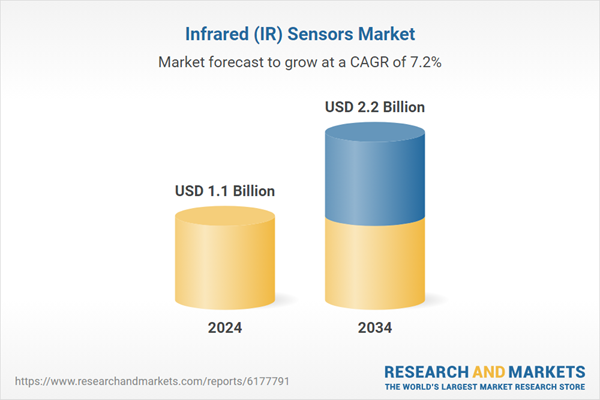Rising deployment of IR sensing across climate monitoring, environmental observation, industry, and consumer electronics is fueling this growth. Infrared sensors provide critical insights into temperature gradients, atmospheric phenomena, and heat signatures data vital for weather forecasting, environmental protection, and disaster resilience. Innovations such as high-resolution thermal imaging, compact detectors, and smart algorithms are driving adoption across sectors. Governments and private entities are integrating IR technology into remote sensing infrastructure, early-warning systems, and urban planning frameworks to strengthen climate resilience. As global attention intensifies on sustainability, pollution control, and ecosystem management, the need for precise thermal data is expanding, thus broadening the addressable market for infrared sensors.
In 2024, the near infrared (NIR) segment generated USD 455.6 million. NIR sensors dominate due to their widespread use in consumer devices facial recognition, gesture sensing, biometric applications as well as in industrial quality control and medical diagnostics. Their cost efficiency, compactness, and ease of integration underpin their popularity.
The uncooled infrared sensor segment was valued at USD 270.8 million in 2024. Uncooled IR detectors strike an effective balance between affordability, compactness, and robustness, making them well suited for consumer electronics, handheld thermal cameras, medical thermography, and industrial safety systems.
U.S. Infrared Sensor Market generated USD 247.5 million in 2024 and will grow at a CAGR of 7.7% through 2034. The American market is powered by investments in defense, remote sensing, autonomous vehicles, and medical imaging. Ongoing wildfires and climate events have heightened demand for high-performance field IR systems, while telehealth expansion is encouraging thermal applications in diagnostics and monitoring.
Prominent players in the Global Infrared Sensor Market include Lockheed Martin Corporation, Melexis N.V., FLIR Systems, Panasonic Holdings Corporation, Hamamatsu Photonics K.K., Omron Corporation, Leonardo DRS, Inc., New Imaging Technologies (NIT), Murata Manufacturing Co., Ltd., InfraTec GmbH, Opgal Optronic Industries Ltd., Excelitas Technologies Corp., Heimann Sensor GmbH, BAE Systems plc, L3Harris Technologies, Inc., Nippon Avionics Co., Ltd., Texas Instruments Incorporated, Raytheon Technologies Corporation, and Honeywell International Inc. Leading infrared sensor firms are focusing on innovation in materials, miniaturization, and integration to boost competitive edge. Many are developing next generation quantum or quantum inspired detectors with higher sensitivity and lower noise. Partnerships with semiconductor manufacturers, camera OEMs, and IoT platforms accelerate adoption.
Comprehensive Market Analysis and Forecast
- Industry trends, key growth drivers, challenges, future opportunities, and regulatory landscape
- Competitive landscape with Porter’s Five Forces and PESTEL analysis
- Market size, segmentation, and regional forecasts
- In-depth company profiles, business strategies, financial insights, and SWOT analysis
This product will be delivered within 2-4 business days.
Table of Contents
Companies Mentioned
The companies profiled in this Infrared (IR) Sensors market report include:- FLIR Systems
- Hamamatsu Photonics K.K.
- Murata Manufacturing Co., Ltd.
- Omron Corporation
- Excelitas Technologies Corp.
- Honeywell International Inc.
- Texas Instruments Incorporated
- Panasonic Holdings Corporation
- InfraTec GmbH
- Kollmorgen (Danaher Corporation)
- Leonardo DRS, Inc.
- BAE Systems plc
- Raytheon Technologies Corporation
- Lockheed Martin Corporation
- L3Harris Technologies, Inc.
- Heimann Sensor GmbH
- New Imaging Technologies (NIT, France)
- Nippon Avionics Co., Ltd. (NEC Group)
- Melexis N.V.
- Opgal Optronic Industries Ltd.
Table Information
| Report Attribute | Details |
|---|---|
| No. of Pages | 350 |
| Published | September 2025 |
| Forecast Period | 2024 - 2034 |
| Estimated Market Value ( USD | $ 1.1 Billion |
| Forecasted Market Value ( USD | $ 2.2 Billion |
| Compound Annual Growth Rate | 7.2% |
| Regions Covered | Global |
| No. of Companies Mentioned | 21 |









